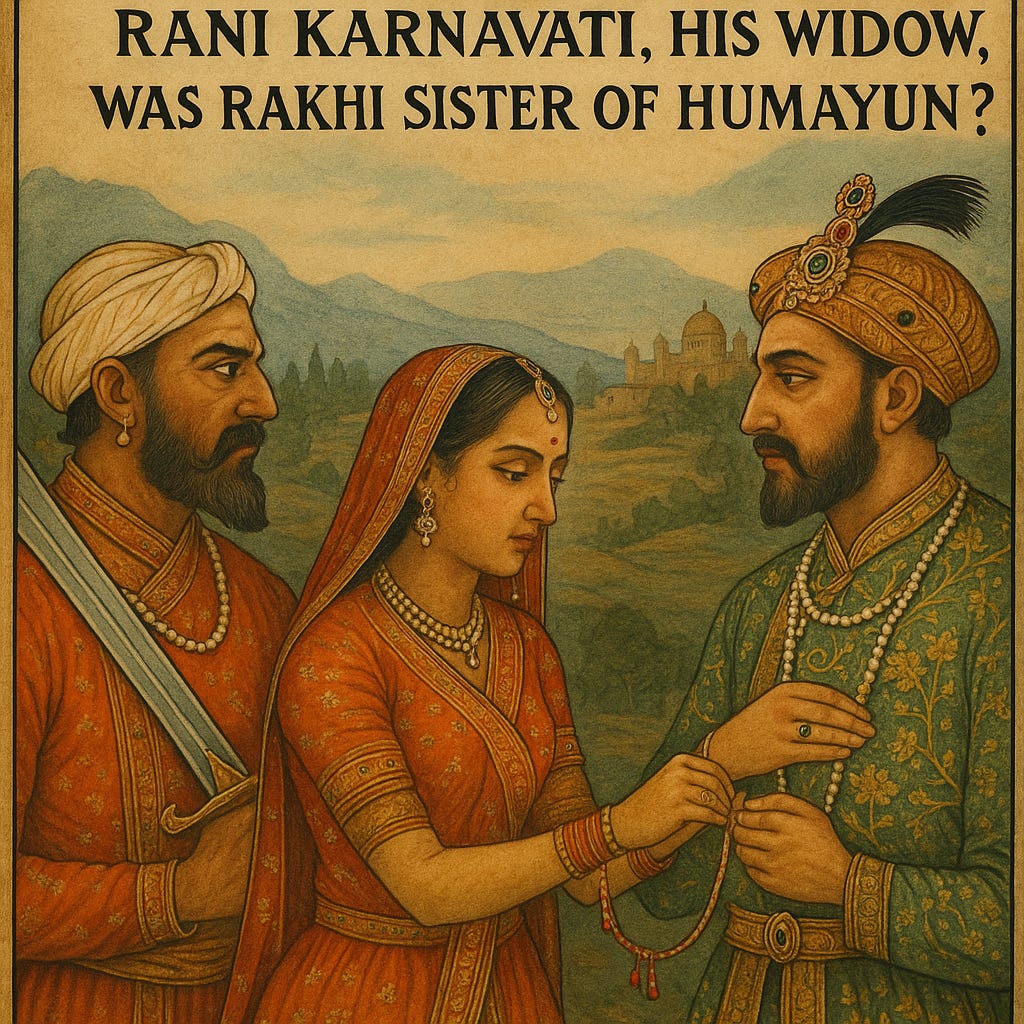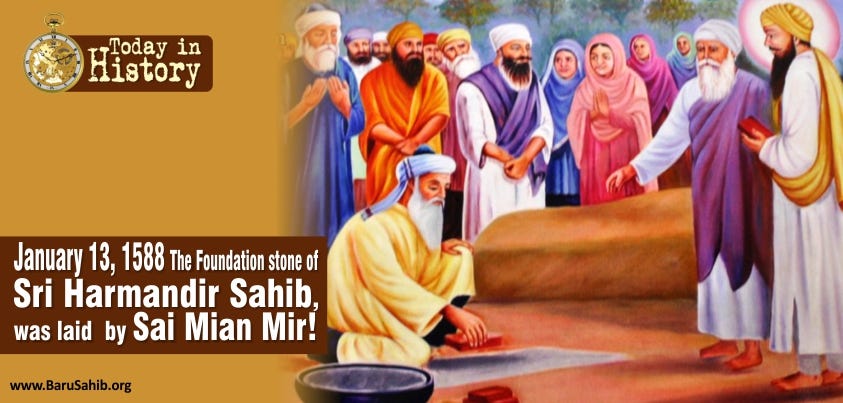Rana Sangha Fought Babur; Rani Karnavati, his Widow, was Rakhi Sister of Humayun?
Examining Historical Events Beyond Legends and Popular Narratives.
By Karan Bir Singh Sidhu
Retired IAS Officer (Punjab Cadre), former Special Chief Secretary; writer and researcher on medieval Indian politics, civilisational narratives, and public policy.
Re-examining a Turbulent Century: Courage, Kinship and the Play of Empires
1. Prelude to Battle of Khanwa – India at the Cusp
The winter of 1526-27 found northern India restless. Ibrahim Lodi was gone, slain at Panipat by a young Timurid prince named Zahir-ud-din Babur. Into the power-vacuum strode Rana Sangram Singh of Mewar, already a legend after humbling the Sultans of Delhi, Malwa and Gujarat. For a fleeting moment these two warriors, Hindu and Muslim, considered joining forces—but each soon realised that the other meant to rule, not merely raid. The stage was set for a confrontation that would decide who carried the future in his saddle-bags.
2. Khanwa – When Cannons Shattered Chivalry
At dawn on 16 March 1527 the plain near Khanwa shook beneath thousands of horse-hooves, Rajput war-drums and the gunpowder thunder of Babur’s Ottoman-style cannon. Rana Sanga’s coalition—Rajput clans side-by-side with Afghan nobles—charged in waves of steel and saffron. Yet bravery met a new calculus of fire. Iron balls tore gaps in the Rajput line; matchlocks spat smoke; Babur’s fortified wagon-circle refused to break. By dusk the lion of Mewar lay grievously wounded, his dream of a Hindu confederacy smashed not by creed but by technology and timing.
The defeat did not erase Rajput honour: stories tell how even Mughal officers marvelled at the fearless advance of Sanga’s men. But the battle confirmed a hard truth—the subcontinent was entering an age where gunpowder, not just valour, would write history.
3. A Widow on the Ramparts – Karnavati’s Vigil
Rana Sanga died the following year. Power fell into the hands of his widow, Rani Karnavati, and her two adolescent sons, Vikramaditya and Udai Singh. Chittor’s granite bastions had witnessed centuries of siege, yet never had they felt so exposed. Rajput nobles muttered that the heir was erratic; rivals circled like hawks. Karnavati smothered her grief, cinched the sword-belt left by her husband, and governed in his stead—convening councils, soothing jealous chiefs, pledging that she would protect the Sisodia line at any cost.
4. The Thread of Hope – Legend of the Rakhi
When Bahadur Shah of Gujarat returned in 1534 with heavy artillery to claim Chittor, Karnavati searched for allies beyond Rajasthan. Tradition says she sent a silken rakhi to Humayun, Babur’s son: a plea wrapped in the language of sibling duty. Whether the thread truly crossed the desert or whether later poets embroidered the tale, the emotional weight remains. A Muslim Emperor could be invoked as a brother; a Hindu queen could expect chivalry from the House of Timur. In that gesture—real or symbolic—lies a reminder that medieval politics was often bolder than modern stereotypes allow.
5. Flames on the Citadel – Jauhar and Saka
Help rode hard from Agra, yet not hard enough. On 8 March 1535 Bahadur Shah’s guns smashed the Rampol Gate and the fate of Chittor tilted. At twilight Karnavati and the women of the fort walked to the jauhar-pit, their white robes sprinkled with sandalwood and saffron. As the torches dipped, the sky glowed red: an act of defiance turning anguish into ash. Outside the walls, Rajput warriors performed saka—a last, furious charge, faces smeared with blood-red ochre, vowing to die un-captured. The night wind carried both roar and lament across the plains.
6. Humayun Arrives – A Brother’s Too-Late Rescue
Humayun reached Mewar days later, his tents pitched among smoking ruins. Some chronicles say he wept when he learnt the queen had perished; others record an austere silence. What is certain is his next act: he drove Bahadur Shah out of Ajmer and Ahmedabad, then summoned young Vikramaditya, wrapped him in a cloak of honour and restored the kingdom to the Sisodias. It was a gesture that spoke louder than any sermon—Muslim sovereign defending Hindu legitimacy, power yielding to principle.
7. The Sun-Scarred Throne – Vikramaditya’s Brief Reign
For five uneasy years Vikramaditya ruled from a scarred fort still smelling of burned ghee and cannon-powder. The court quarrelled, coffers were thin, and grief lingered like a monsoon haze. In 1536–37 a palace intrigue ended his life; a cousin seized the crown until Panna Dai spirited little Udai Singh to safety. Yet for all its brevity the prince’s reign, made possible by Humayun’s protection, proved that the Mughals could be patrons as well as rivals.
8. Death at Diu – Bahadur Shah Meets the Sea Wolves
Far to the west the Gujarati Sultan who had brought Chittor to its knees sought naval aid against the Mughals from a new maritime power—Portugal. In February 1537 he boarded a Portuguese galley off Diu to parley. The meeting spiralled into treachery; blades flashed, and Bahadur Shah’s body was cast into the Arabian Sea. European cannon, not Indian, ended his dynasty’s golden age. The irony is stark: while Indian courts wrestled for supremacy, a crescent of colonial ambition began encircling their shores.
9. Reframing the Past – Conflict, Alliance and Shared Destiny
These intertwined lives—Babur and Sanga, Karnavati and Humayun, Bahadur Shah of Gujarat and the Portuguese captains—show an India where faith, honour, ambition and technology clashed and coalesced in unpredictable ways. The notion that Mughal rule was an unbroken saga of Muslim tyranny over Hindu valour dissolves in the face of Humayun’s chivalry and of Rajput-Muslim coalitions at Khanwa. Equally, the tragedy of Chittor reminds us that bravery did not always prevail, and that women bore stakes as high as any king.
To read this quarter of century only as a tale of religious conquest is to miss its deeper pulse: human beings—proud, fallible, courageous—who forged brotherhood across creeds, fought duels of cannon and courage, and together confronted the first distant thunder of European empire. In their stories India finds not just narratives of oppression, but a tapestry of shared destiny, stitched with both silk threads and sword-cuts.
Beyond Divisions: Chronicling Sikh-Muslim Instances of Amity in History
Introduction— history of hostilities: Throughout history, narratives have perpetuated the notion of animosity between Sikhs and Muslims. Tragic events, especially the martyrdom of the two Sikh Gurus, Guru Arjan Dev Ji and Guru Tegh Bahadur Ji, and the unparalleled sacrifice of the four "





